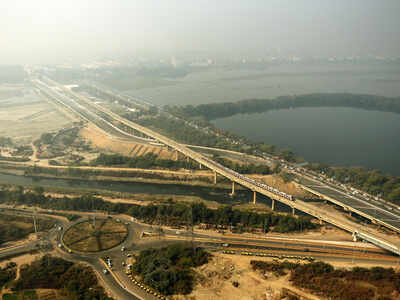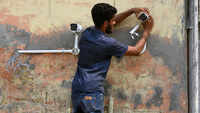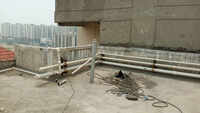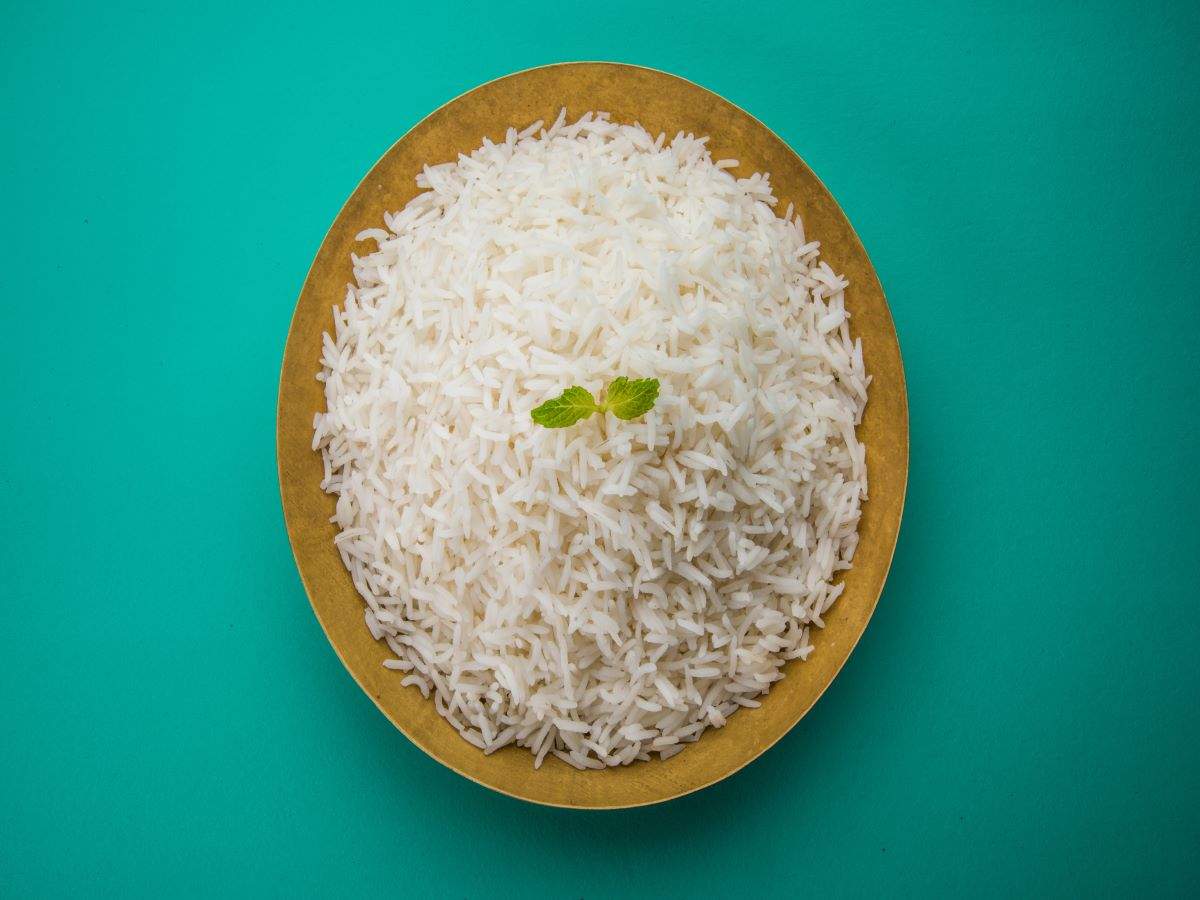
NEW DELHI: A tumbler of dry river sand can hold a substantial amount of clean water, which can be retrieved later for use. This sub-surface storage capacity of sand, enlarged on a massive scale, could help Delhi meet its water shortage, chief minister Arvind Kejriwal said while announcing a recharging pilot project on the Yamuna floodplain on Tuesday, a pilot for which will start this monsoon season.
Taking the cue from studies by National Institute of Hydrology, IIT-Delhi and the Central Ground Water Board, Delhi government proposes to create a 1,000-acre underground reservoir on the Yamuna floodplain in northwest Delhi's Palla to store an estimated 37,000 million gallons of rainwater, enough to meet the city's peak summer water supply shortfall.
Delhi gets 580 million cubic metres (MCM) of rainwater every monsoon season, but 280 MCM of this is lost because there is no way to store it. The Palla reservoir is being conceived as storage for the seasonal precipitation. Ankit Srivastava, technical advisor to Delhi Jal Board, clarified that though it is being called a reservoir, the facility will not look like a shallow lake. Instead it will be an expansive sand field with craters (shallow pits) across the area.
Palla to have a sand field with water pits
Delhi gets 580 million cubic metres (MCM) of rainwater every monsoon season, but 280 MCM of this is lost because there is no way to store it. The Palla reservoir is being conceived as storage for the seasonal precipitation. Ankit Srivastava, technical advisor to Delhi Jal Board, clarified that though it is being called a reservoir, the facility will not look like a shallow lake. Instead it will be an expansive sand field with craters (shallow pits) across the area.
The selected site, a 200-600-metre wide stretch lying between Yamuna riverbank and the bunds made by the irrigation and flood control department, is currently being used for agriculture. Delhi government has formed a five-member committee to negotiate the transfer of this expanse on lease for three years. The panel has been asked to submit its report by July 8. Based on the current crop recovery by farmers, the lease cost of the 1,000 acres is estimated at Rs 5 crore. In the Delhi budget, Rs 100 crore has already been allocated for groundwater conservation projects.
The floodplain has a very high percolation rate of 6-9m per day and arrangements will have to be made to hold the water for a few hours. “The top 1-1.5m of the expanse will be removed to prevent pesticides/fertilisers seeping into the water and polluting the aquifers,” said Srivastava. “The numerous craters will serve the purpose of exposing the sand bed and enhancing the percolation.”
A DJB official disclosed after studies carried out using MODFLOW software, that “the water seeping down is expected to move towards Alipur”.
Srivastava said that data of the last 10 years suggest 18 flooding cycles every rainy season when water levels rise to 208m. “With each cycle yielding 2,100 million gallons of water, we estimate that we will have over 37,000 MG water to store,” he noted. Delhi has a demand-supply gap of 250-300 million gallons per day, and this stored water can be used to meet the peak summer demand. Extraction of 100MCM will be enough for a month’s water demand.
DJB has an installed waterextraction infrastructure of 106 tubewells and four Ranney wells that take out around 25 MGD of water every day. Anil Singh said, “The Yamuna floodplain already feeds 10 lakh homes in Narela and Bawana. On average, the underground storages are left idle for 4-5 hour daily for recovery. If we can increase the artificial recharge through flooding, the project will become a national asset.” Singh operates the automated supervisory control and data acquisition (SCADA) centre to monitor the Yamuna water level and other parameters for a number of facilities along the river embankment.
The idea of a reservoir of this sort dates back several decades. A 1996 CGWB study had suggested 78 MCM of surplus monsoon runoff being used to recharge the dewatered aquifers. A 2017 study by Vikram Soni, professor emeritus at Jawaharlal Nehru University, stated that “for a river length of 20 km, we can expect about 100 MCM of annual sustainable withdrawal”. An Intach study in 2015-16 too had concluded, “The floodplain has prolific aquifers. The hydro-geological setup and availability of substantial quantity of flood flows are favourable for augmentation and exploitation of groundwater resources.”
Intense lobbying is on to convince the central government and inter-state agencies to come on board on the project. Dinesh Mohaniya, DJB vice-chairman, said a meeting was held to discuss the matter with the Union Jal Shakti ministry. “They recognise water is being wasted and have agreed in principle to support the project,” Mohaniya said. “There are some points of differences over the potential of storage, so DJB and CGWB will jointly carry out a survey to arrive at a consensus.”
Taking the cue from studies by National Institute of Hydrology, IIT-Delhi and the Central Ground Water Board, Delhi government proposes to create a 1,000-acre underground reservoir on the Yamuna floodplain in northwest Delhi's Palla to store an estimated 37,000 million gallons of rainwater, enough to meet the city's peak summer water supply shortfall.
Delhi gets 580 million cubic metres (MCM) of rainwater every monsoon season, but 280 MCM of this is lost because there is no way to store it. The Palla reservoir is being conceived as storage for the seasonal precipitation. Ankit Srivastava, technical advisor to Delhi Jal Board, clarified that though it is being called a reservoir, the facility will not look like a shallow lake. Instead it will be an expansive sand field with craters (shallow pits) across the area.
Palla to have a sand field with water pits
Delhi gets 580 million cubic metres (MCM) of rainwater every monsoon season, but 280 MCM of this is lost because there is no way to store it. The Palla reservoir is being conceived as storage for the seasonal precipitation. Ankit Srivastava, technical advisor to Delhi Jal Board, clarified that though it is being called a reservoir, the facility will not look like a shallow lake. Instead it will be an expansive sand field with craters (shallow pits) across the area.
The selected site, a 200-600-metre wide stretch lying between Yamuna riverbank and the bunds made by the irrigation and flood control department, is currently being used for agriculture. Delhi government has formed a five-member committee to negotiate the transfer of this expanse on lease for three years. The panel has been asked to submit its report by July 8. Based on the current crop recovery by farmers, the lease cost of the 1,000 acres is estimated at Rs 5 crore. In the Delhi budget, Rs 100 crore has already been allocated for groundwater conservation projects.
The floodplain has a very high percolation rate of 6-9m per day and arrangements will have to be made to hold the water for a few hours. “The top 1-1.5m of the expanse will be removed to prevent pesticides/fertilisers seeping into the water and polluting the aquifers,” said Srivastava. “The numerous craters will serve the purpose of exposing the sand bed and enhancing the percolation.”
A DJB official disclosed after studies carried out using MODFLOW software, that “the water seeping down is expected to move towards Alipur”.
Srivastava said that data of the last 10 years suggest 18 flooding cycles every rainy season when water levels rise to 208m. “With each cycle yielding 2,100 million gallons of water, we estimate that we will have over 37,000 MG water to store,” he noted. Delhi has a demand-supply gap of 250-300 million gallons per day, and this stored water can be used to meet the peak summer demand. Extraction of 100MCM will be enough for a month’s water demand.
DJB has an installed waterextraction infrastructure of 106 tubewells and four Ranney wells that take out around 25 MGD of water every day. Anil Singh said, “The Yamuna floodplain already feeds 10 lakh homes in Narela and Bawana. On average, the underground storages are left idle for 4-5 hour daily for recovery. If we can increase the artificial recharge through flooding, the project will become a national asset.” Singh operates the automated supervisory control and data acquisition (SCADA) centre to monitor the Yamuna water level and other parameters for a number of facilities along the river embankment.
The idea of a reservoir of this sort dates back several decades. A 1996 CGWB study had suggested 78 MCM of surplus monsoon runoff being used to recharge the dewatered aquifers. A 2017 study by Vikram Soni, professor emeritus at Jawaharlal Nehru University, stated that “for a river length of 20 km, we can expect about 100 MCM of annual sustainable withdrawal”. An Intach study in 2015-16 too had concluded, “The floodplain has prolific aquifers. The hydro-geological setup and availability of substantial quantity of flood flows are favourable for augmentation and exploitation of groundwater resources.”
Intense lobbying is on to convince the central government and inter-state agencies to come on board on the project. Dinesh Mohaniya, DJB vice-chairman, said a meeting was held to discuss the matter with the Union Jal Shakti ministry. “They recognise water is being wasted and have agreed in principle to support the project,” Mohaniya said. “There are some points of differences over the potential of storage, so DJB and CGWB will jointly carry out a survey to arrive at a consensus.”
World Cup 2019
Trending Topics
LATEST VIDEOS
City
 Car gets stuck in water-logged subway in Mumbai's Malad, two men found dead
Car gets stuck in water-logged subway in Mumbai's Malad, two men found dead  'Extremely unfortunate’: Actor-turned-politician Sunny Deol tweets on row over appointing 'representative'
'Extremely unfortunate’: Actor-turned-politician Sunny Deol tweets on row over appointing 'representative'  1.4 lakh more CCTV cameras in second phase in Delhi
1.4 lakh more CCTV cameras in second phase in Delhi  Why no finance panel in MCG, councillors questioned mayor Madhu Azad
Why no finance panel in MCG, councillors questioned mayor Madhu Azad
More from TOI
Navbharat Times
Featured Today in Travel
Quick Links
Lok Sabha Election Schedule 2019Lok Sabha Election NewsDelhi Capitals teamMI team 2019Rajasthan Royals 2019RCB team 2019Maharashtra Lok Sabha ConstituenciesBJP Candidate ListBJP List 2019 TamilnaduShiv Sena List 2019AP BJP List 2019Mamata BanerjeeBJP List 2019 MaharashtraPriyanka GandhiBJP List 2019 KarnatakaAMMK Candidate List 2019BJP List 2019 WBLok Sabha Elections in Tamil NaduBSP List 2019 UPNews in TamilLok Sabha Poll 2019Satta Matka 2018PM ModiMahagathbandhanNagpur BJP Candidate ListChandrababu NaiduTamil Nadu ElectionsUrmila MatondkarNews in TeluguMadras High CourtTejashwi YadavArvind KejriwalTejasvi SuryaPawan KalyanArvind KejriwalYogi AdityanathJaya PradaSatta King 2019Srinagar encounter
Get the app





